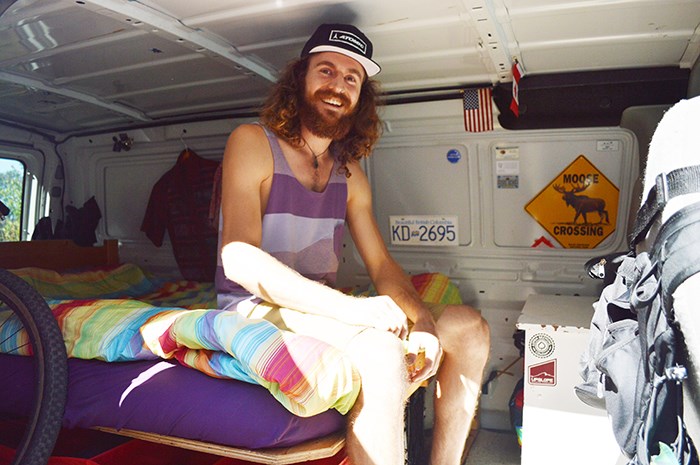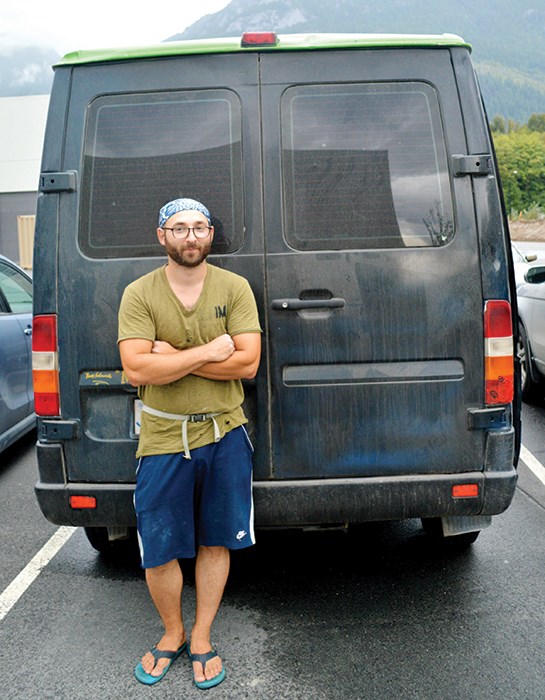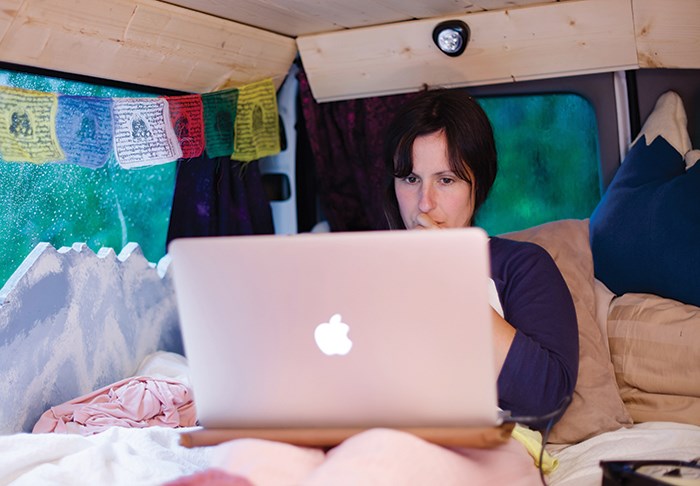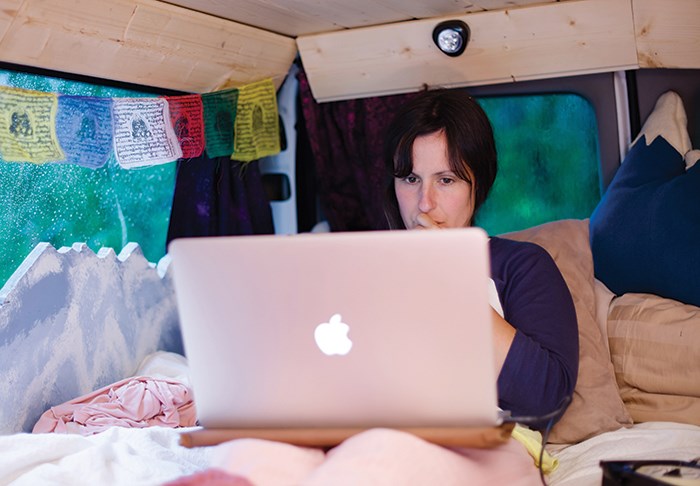Living in a vehicle is not a new phenomenon.
Though vans may lack some of the comforts of a traditional home, such as plumbing and running water, a vehicle also lacks the burden of a monthly rent cheque, a quality that has drawn the budget-conscious and mobile-minded to their backseats, trunks and cargobeds for decades.
In Squamish, an outdoor adventurer’s paradise where housing costs are skyrocketing while available housing options are plummeting, living in a vehicle has become a major trend and an increasingly appealing option in recent years.
Local mechanic Ken Dixon estimates nearly one-third of his customers live in their vehicles, a number he says has grown tremendously since he opened his auto shop in Squamish four years ago.
“It’s a huge uprising trend,” said Dixon. “My clients that live in their van have probably more than tripled since I moved to Squamish. People aren’t apprehensive to do this; they’re wanting to do this.”
Alex Roe and Marta Merino run the popular blog and YouTube channel Wanderlust Vanlife, which, in addition to showcasing their travels, also offers tips and quips about what exactly the van life entails. The couple spent three weeks in Squamish living in their van last summer.
“Sea to Sky does have a large number of van-dwellers, being one of the busiest places we visited,” they said in an email from Australia. “We only see these numbers in areas with a high amount of outdoor activity coupled with high rental prices.”
But make no mistake, this influx of van-dwellers aren’t all living in barren, run-of-the-mill cargo vans and vintage volkswagen campers. These vehicles are often uniquely adapted to make life on the road as comfortable as possible.

Photo: Jayden La Dru sits inside his van home.
“For one guy, we put solar panels on the roof so he can use his laptop all day,” Dixon said. “There are so many cool things you can do.”
Another of Dixon’s customers, Boris Peresechensky, bought a cargo van last August that was previously used to deliver cucumbers. He moved in during March, after spending the winter months researching, planning and building a custom interior for his new home.
Peresechensky’s van, which he parks at different locations around Squamish, is fully insulated, boasting a roof vent and hardwood floors. It’s equipped with a cooktop, retractable cutting boards, LED lights, an L-shaped bench that seats five comfortably with storage underneath that pulls out to form a twin bed, a fold-down table for eating and entertaining and even a dedicated space for his yoga mat.
“A big thing for me was maximizing hangout space,” he explained.
Peresechensky says the van life was his best option after the seriousness of Squamish’s housing crunch caught up with him.
“At some point, my landlord sold the house from under us and the new owners had no interest [in having tenants], so we had to leave,” he explained. “Anyplace else was a 400 or 500 dollar-a-month rent increase, which was unreasonable. This was the next best thing.”
To many van-dwellers, not having to worry about writing a costly rent cheque each month isn’t necessarily the main reasoning behind their lifestyle choice, but an added bonus.

Boris Peresechensky and his van home.
When Jayden La Dru relocated to the Sea to Sky from Australia last October, it served as the perfect opportunity to realize a long-time dream.
“I’ve always wanted to live in a van,” he said. “It’s a mobile home, so you can travel whenever you want.”
Upon his arrival in Squamish, La Dru spent two weeks scouring Craigslist for vans before becoming the proud owner of a utility van that was formerly used by a telephone company, which he dubbed “The Chief” after the mountain.
“It’s completely gutted out,” La Dru described. “It had bare floors, bare walls… I’ve just kitted it out myself, inside. I believe in the recycle revolution, so everything in there is recycled. The bed, the stove, everything is second hand.”
In addition to saving him money and providing freedom of mobility, La Dru say his living situation has also had a positive effect on his social life.
“There’s a sense of community,” he said. “You don’t want to hang out in your van all day, so you go to friends’ houses.”
But despite the popularity and appeal of this alternative housing situation, there’s more to life in a van than the benefits and convenience of a mobile home.

Marta Merino on her laptop. Photo by Alexander Roe.
“It’s been awesome… [but] it’s not all glory,” said Peresechensky. “Charging my phone is the bane of my existence. There have definitely been times where I’ve had an extension cord running out into a Wal-Mart parking lot... because I needed to do something with my computer quickly.
“If I had to give somebody advice, I’d say, ‘don’t think it’s all awesome.’ Get used to peeing in a bottle.”
La Dru agrees that living in a van demands a certain learning curve, especially when it comes to life without a bathroom on board.
“You have to plan your day,” he said. “You need to know how your body works and work around that. But that’s what 24-hour McDonalds are for.”
Oftentimes, van-dwellers can fall victim to their own mobility. Yet another issue they must consider is the lack of a permanent address, or, in their case, a permanent parking spot.
“You need to keep moving,” explained La Dru. “That’s the hardest part. Some spots, you can’t stay for too long before people start to think ‘hey, that guy’s camping in there.’”
During their stay in the Sea to Sky, Roe and Merino avoided this problem by using Wal-Mart parking lots and campsites.
In summer months, La Dru often parks in friends’ driveways, though he says his favourite spots are a little more out of the way.
“Lookouts are the best,” he said. “You get million-dollar views, and you don’t pay a cent for them.”
Though Peresechensky’s workplace has a large parking lot, he chooses not to keep his van there overnight.
“There are businesses here. They don’t want to breed the culture of having people live in their parking lots,” he said, adding that he prefers to find stealthy, low-impact parking spots in urban areas or forest service roads.
“There’s a big problem in Squamish right now with visiting members of the van-dwelling community who don’t respect what is typically considered proper etiquette when you come to a new area.
“Just because you live in a van, doesn’t mean that everywhere you park is your house.”
But despite the many obstacles that accompany this lifestyle, these van-dwellers can all agree that the benefits of van living are well worth the troubles.
“The advantages far outweigh the disadvantages for us,” said Roe. “Moving into a small space demands a simplified life which, in itself, has many positive effects for both mind, spirit and relationship. The lifestyle is beautiful.”
“It’s so much fun,” added La Dru.
“You learn a lot about the things you take for granted in a house and how cheaply and simply you can live.”



